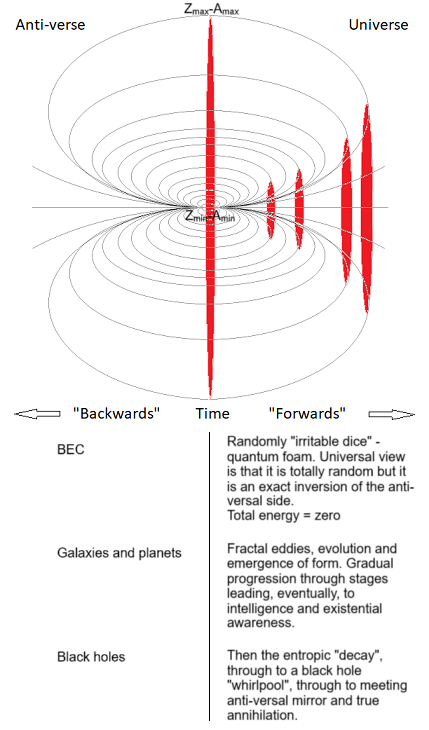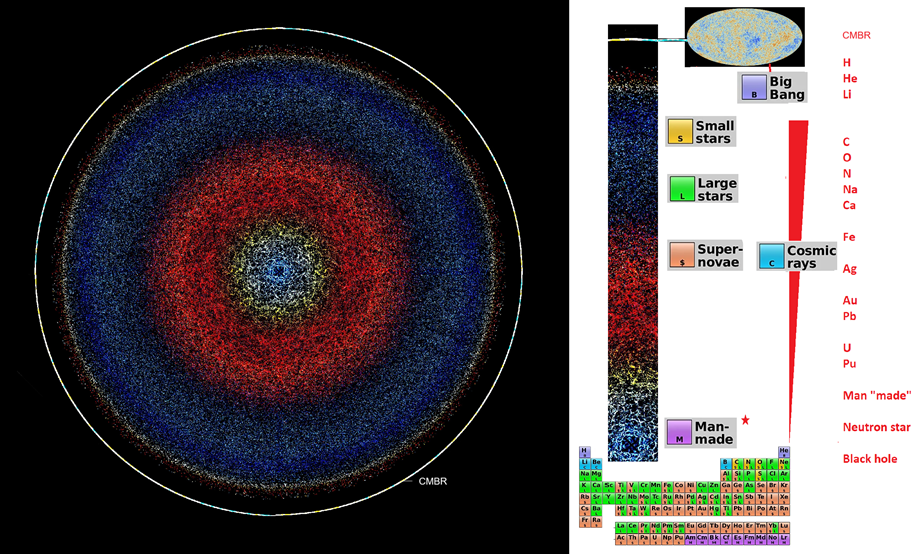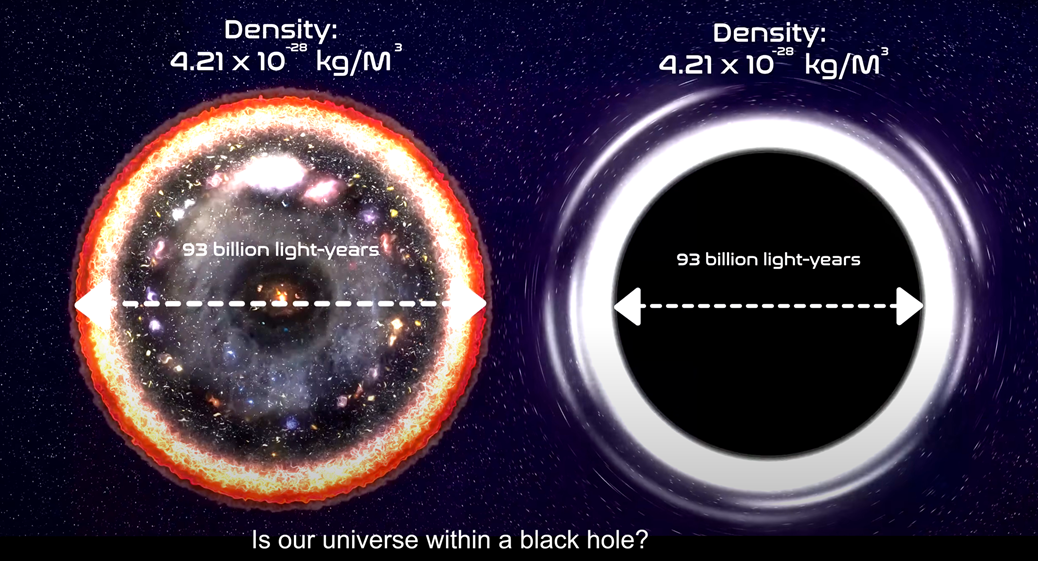Further observations about physics – split files
(29) Deep (really deep!) intergalactic space and Bose-Einstein condensate
Deep intergalactic space, that typifies the most remote voids in the universe, has hardly any influx of radiation. Is it possible that these "places", though sparsely populated by particles and atoms, form a Bose-Einstein Condensate (BEC). Virtually, by definition, their constituent waves lose individuality and the whole process becomes a coherent superstructure without definition and, possibly, without the usual spatial bounds? Is it akin to a process like cosmic inflation, where every part of the BEC is in contact/communication with the whole enveloping BEC? This might be worth a thought. Note also, that this is a "place" where the passage of time will be on the balance point between appearing to go forwards and appearing to go backwards (from our perspective, of course). That means that, if our universe is the "product" of a universe and a mirror image anti-verse, their (two) representative deep intergalactic voids coincide at this "point" (really a "state") and are, possibly, "fused" into one (enormous) Bose-Einstein condensate and, thus, become one entity (functionally analogous to the glass table top with dice strewn over it – mentioned below).
Note that, in the diagram below of the "composition" of the universe, even these voids are surrounded by an envelope of a great deal more "void" outside of the point where stars and galaxies first formed. These are "near" the 13.7 bn light yrs distance. (I am assuming that the distance is at least this – the invisible universe may be more.)
Perhaps this is where all this is heading:–
There are two "places" where the passage of time seems to be ("instantaneously") at a standstill. One is at the singularity of a black hole/big bang (represented by the "interval" Zmin-Amin) where, for us matter at the event horizon seems to linger for ever. The other is the deepest, remotest regions of deep intergalactic space where conditions favour an enveloping Bose-Einstein condensate (BEC) and is represented by the lighter, coloured "ring". This also surrounds the time toroid shown in the figure and, there, it is denoted by Zmax-Amax.

It is here, at the surrounding BEC that the natural "irritability" of quantum foam randomly posits balanced quantum pairs (like electron positron pairs) either side of the "midline" (antiversal and universal). The majority of these will immediately annihilate but, in the vastness of deep intergalactic space, occasional virtual particle may reach a point where they are "rectified" into a more permanent existence. Provided they stay "rectified", the resulting (now real) particles will appear to emerge randomly to an observer on one particular side of the universe/antiverse divide. One side will be an exact energy "mirror" of the opposite, antiversal, side (remember the tossed dice on a glass table; we can employ the analogy of special six sided dice that have +3 opposite -3, +2 opposite -2 and +1 opposite -1 where the top plus bottom always add up to zero). The top (upper) distribution could be totally random but, as the two sides are in a perfect energy balance (sigma zero), should they be able to meet and interact, they would truly annihilate to zero/zilch/nothing (not like the misnomer of the "annihilation" talked of when a universal electron meets a universal positron (where the two leptons evaporate into pure energy).
In between the BEC and the singularity is a vast expanse of space where particles can “rain down” so that evolution and emergence can take place. There, the fractal eddies of particles "generated" by the BEC can evolve into ever more complex patterns (particles to atoms to stars to planets to life to intelligent animals to complex social structure to existential understanding). But this can only happen whilst dangled between the enveloping BEC and multiple black holes. So, what happens as matter is "drawn into" the mouth of the black holes and towards the singularity? It could cross the event horizon and meet its true antiversal mirror and now true annihilation (to zero/zilch/nothing) is possible. However, the slowing of the passage of time ensures that the gravitational attraction continues as both an echo and the still proximal antiversal matter (probably dark matter made of, primarily, neutrinos – antiversal leptons – that are close to but still "beyond" the event horizon). Because the passage of time slows to a standstill very near the "crossover", the gravitational "attraction" appears to persist even though the 13.7 bn yr old BEC crossover debt is paid back "inside" the event horizon. What is the rectifier? Probably the relative motion of a vast majority of neutrinos that "exceed" the speed of light and are thus unable to dock with universal matter (atoms; note that occasional neutrinos may, by chance, slow to near to the SoL – velocity of light in this instance – necessary to enable docking with an atom and so register an interaction). Note, that in the antiverse, what we perceive as neutrinos fulfil the role of electrons, muons and taus and the universes electrons, muons and taus will look like neutrinos to an antiversal observer.
So we have a situation where the fractal eddies between BEC and black hole "singularities" favour emergence and evolution of ever more complex forms around stars and galaxies. Gradual and progressive evolution becomes the "norm". There may be bursts of larger and more rapid steps but it will be mostly incremental and progressive. We think of evolution as being through time but jnspect this representation of the universe closely. It is taking place against a backdrop where 13.7 bn yrs ago equates to 13.7 bn light yrs of distance (the space:time ratio is 1:1).
The 13.7 bnYr ring (an enveloping sphere really) of the microwave background radiation may be "bent around" more proximal matter. This may be our our view of antiversal black holes and appear to us as now as a surrounding spherical horizon - the so called echo of the "big bang". If, however, the passage of time reverses (from our perspective) at the BEC and in this deep intergalactic space, then the interval from the BEC to the Big bang is identical to the intervcal from a BEC to our black holes. It may not be simply an "exploding" and expanding universe enlarging from a big bang but an evolution of antiversal strucures parallel to to the universal structures (hydrogen, helium iron neutron stars) that emerge in succession from the BEC to close galaxies. This diagramatic ring may be our view of the antiversal "singularity" interpreted by us now as a "big bang". This can be represented by the passage of time to the left and right of the time torus presented earlier. The widest and central slice of the torus (the "time doughnut") reflects a maximum spatial extent (of "13.7"bn light yrs). Remember, this particular diagram represents only one spatial and temporal dimension, so three of these may combine to give a "spherical" space of the universe – and that implies there are three equivalent rectangular time dimensions.
I have already suggested that gravity may be an electromagnetic attraction where a subtle closer proximity to electron or positron shells will bias repulsion or attraction because (although perfectly balanced neutralisers) the charges of deeper nuclear structures are "further" away. This is comparable to the electric repulsion of electron shells when, for example, we walk into an unnoticed glass door.
So that gives a fairly attractive explanation of how we can pack so much matter into un unimaginably tiny space.
It is worth noting, once again, that at the event horizon of a black hole – because the passage of time is so slowed up from our perspective – other black hole event horizons may appear, to each of other, to be much "closer" together than we appreciate them (think space-time).

Finally, there is an argument that we may exist inside a black hole (event horizon). That adapts satisfactorily with this idea.

OK !! This is clearly wrong in its exact interpretation and needs adjusting and greater insight. The simplistic idea that time is running in a reverse direction in the antiverse than it is in the universe is clearly inadequate; BUT it will be temporarily useful. The twin paradox claims that a twin travelling away from earth (right around the galaxy for example) at the SoL would return with the travelling twin having aged far less than the stay-at-home twin. However, in deep intergalactic space, if both twins were separating apart at the SoL (is there an absolute point that we could call stationary?) this would leave both twins "believing" that they are each ageing less rapidly than their respective twin (given the improbability that they could communicate in any way). The observing twin will perceive the passage of time to slow as his "brother's" recession approaches the SoL: but this brother will also see his twin receding from him at the SoL and his perspective will be that it is his brother's passage of time that slows in exactly the same way. The “static” observer and "travelling" observer is entirely relative (what is static?). The perspective painted above, of going around in reverse time is, I think, not a satisfactory explanation though it has a slight ring of temporary value to it. What can be said, though, is that, from the universal viewpoint, the antiversal component seems to be "travelling" (at least parochially) dominantly in distance and the universal component dominantly in time. Spacetime suggests to me that every place/time event exists ["permanently"] but we can only experience it in a way that is analogous to reading a sequence of data on a revolving CD. Then there is the mirror idea. Energy (improbability) levels should, indeed, be perfectly matched either side of the universe/antiverse divide and able to truly annihilate on "meeting" (like the dark places in an photonic interference pattern). So that imples the existence of positive and negative energy elements.
Also, could there possibly be an exact mirror image of me walking around my home in the respective antiverse? I guess only if all the nows are very close together but unable to interact ("rectified"); that seems improbable. Also, if the antiverse with its electons and positrons appear to us as neutrinos (and vice versa, of course) then these, in turn, are probably the "source" of dark matter. When two galaxies "collide" and pass through one another, their matter and dark matter appear to be ripped apart (at least temporarily). So universal matter carries its local halo of dark matter along with it. That's another clue to say that time reversal is, at most, a parochial situation. But it does indicate that time and space in spacetime can distribute dominantly towards either time or space provided the balance is maintained overall. All this needs much more thought.
One thought that may enlighten this apparent alteration in the passage of time comes from a sine wave. If we observe a sine wave from the perspective of circular motion that traces out a path on a forward time x-axis, we miss the oscillatory circular track that is superimposed on a "travelling" time x-axis. Here, the circle boundary stays in the same place but the pendular radius borrows then repays time. It is now more obvious that time is alternately accelerated forwards then decelerated backwards in a cyclical borrow/repay manner. So it's not a true reversal of time but it does have that effect. If we now impose this on a system where time is generated by spatial oscillation rather than on a background of an inexorable and inescapable year 2000 to year 2025 passage of time (Newton's vs Einstein's time), then we can see that negative time is little more than spatial oscillation forwards and backwards; position/location begets time.